Worldless was provided by Thunderful Publishing for review. Thank you!
This game was tested with a Steam Deck LCD. OLED testing is coming soon.
Worldless is an interesting game. It is a Metroidvania-style 2D Platformer kind of affair, with a focus on solving fairly simple puzzles and executing timed commands in a turn-based combat system. It can feel a bit minimal when it comes to the visuals, but this is a great experience nonetheless, with its enjoyable combat.
The game adopts a fairly minimalist approach, not only in terms of visuals but also its story. Dialogue is limited and always shown via text. Ultimately, you're put into the game world with basically no direction, so you're free to explore as you wish, which means you can also end up in areas with very strong enemies without any warning from the game.
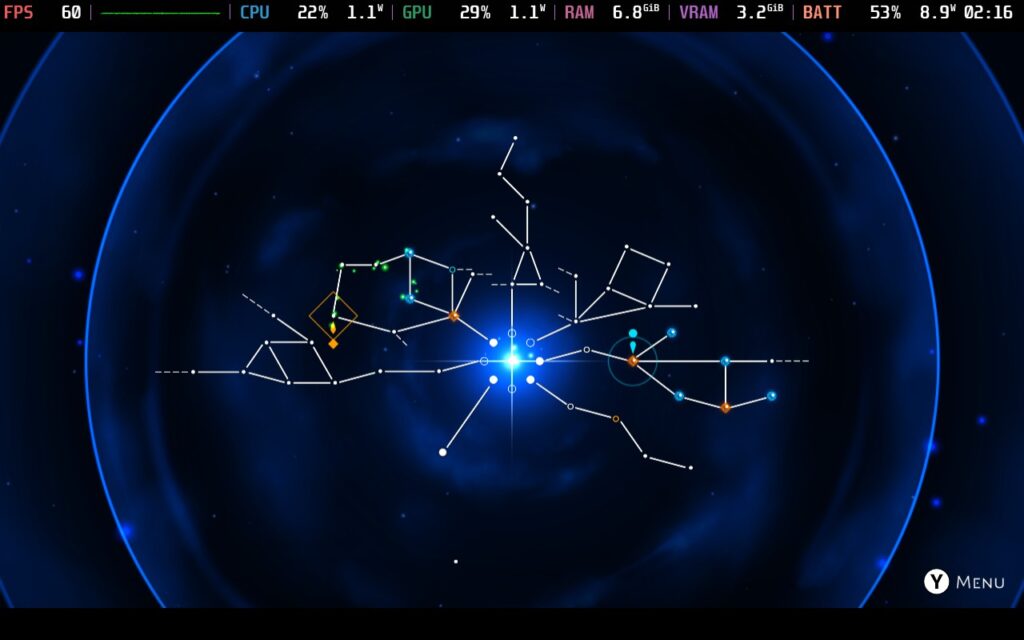
My experience with the game's "puzzles" was a bit bland. They seemed to always consist of the same basic idea of using the "Y" button at certain points to make platforms or jump pads appear, but the game's combat is what makes this worth playing.
The combat utilizes turn-based, or perhaps more accurately, time-based commands to fight. When your turn begins, you have a few seconds to execute your attacks and combos, using a mixture of physical and magic attacks, to break through the enemy's shield and attack their life directly. When your turn is over, the enemy will try to do likewise to you, but you can press a button at the right time to defend against their attacks.
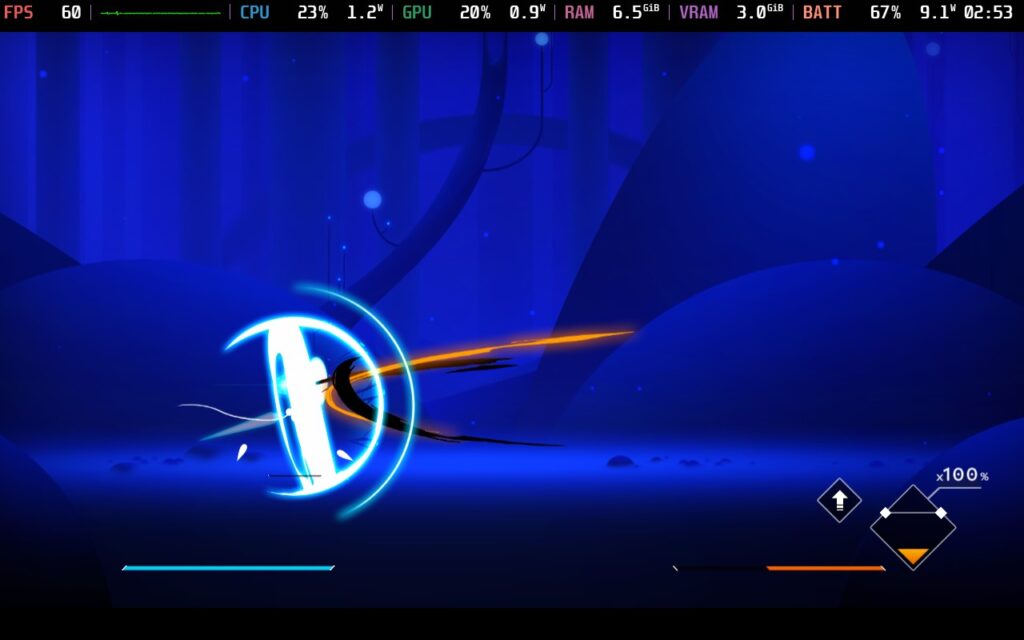
This creates a very skill-based combat system that greatly rewards reaction timing and the ability to read enemy attacks as they are about to happen. It's very satisfying when you get it right and execute what the game calls a "perfect guard," which can give you bonuses and means your shield stays strong under the enemy's attacks.
Speaking of skills, the game has a rather extensive skill tree, considering the length of the game itself. This allows you to strengthen your shield, unlock new attack combos, or give you more time to execute your commands. This helps keep the combat feeling fresh throughout the playthrough and is a nice addition.
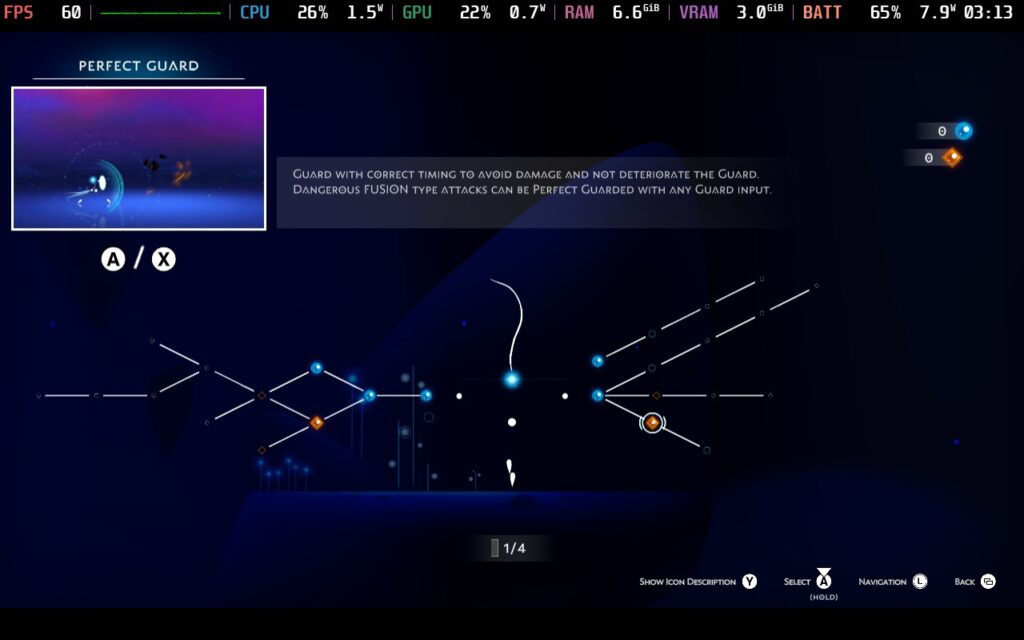
The visuals are minimalist and pleasantly styled, in my opinion, they do their job and make it easy to discern points of interest from general scenery. I'd hesitate to call it "beautiful," but it's certainly appealing at points. And I would never describe it as "ugly."
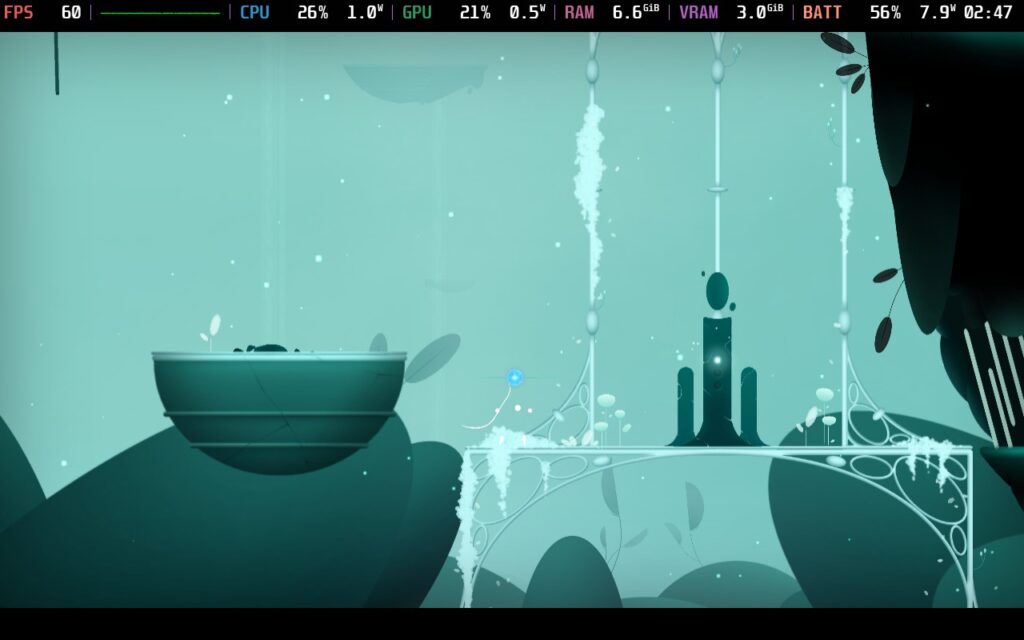
I liked this foray into the Metroidvania genre. The combat is the highlight here for me, and pulling off combos and executing perfect timing is well-rewarded. The skill tree adds variety to your combat options over time and helps the game feel fresh throughout.
But how does it run on the Steam Deck? We've got some good news for you!
Worldless starts quite well on the Deck. The game boots with a 16:10 resolution, and there is a nice notice that the game is best played with a controller. And we can confirm that this is the case, the game plays beautifully on a controller and was designed with it in mind.
There are no graphical options here aside from resolution, which we don't want to touch, so we can't "optimize" the game itself. All the settings that we adjust will be in the SteamOS Quick Access Menu.
First, we'll set a 60 FPS/Hz lock in our SteamOS settings, then put a 6W TDP limit on. Worldless is a very lightweight game and can often hit 60 FPS with a lower TDP limit than 6W, but in combat or when many particles are in play, it causes drops. A 6W Limit holds us nicely at 60 FPS for 99% of the time, and the odd dropped frame during combat wasn't really noticeable since the visuals are pretty busy anyway during those points.
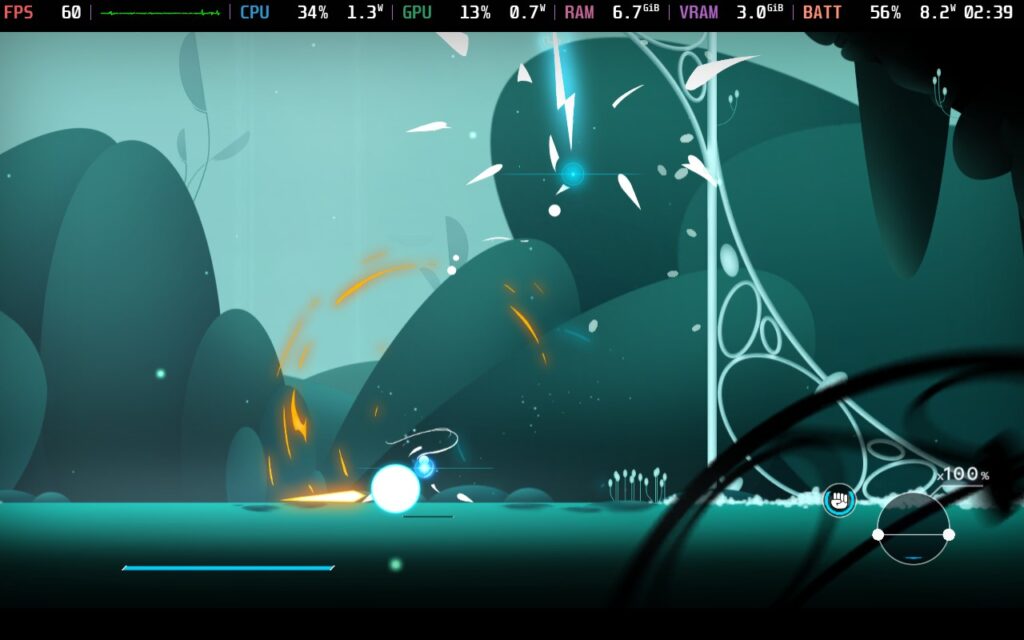
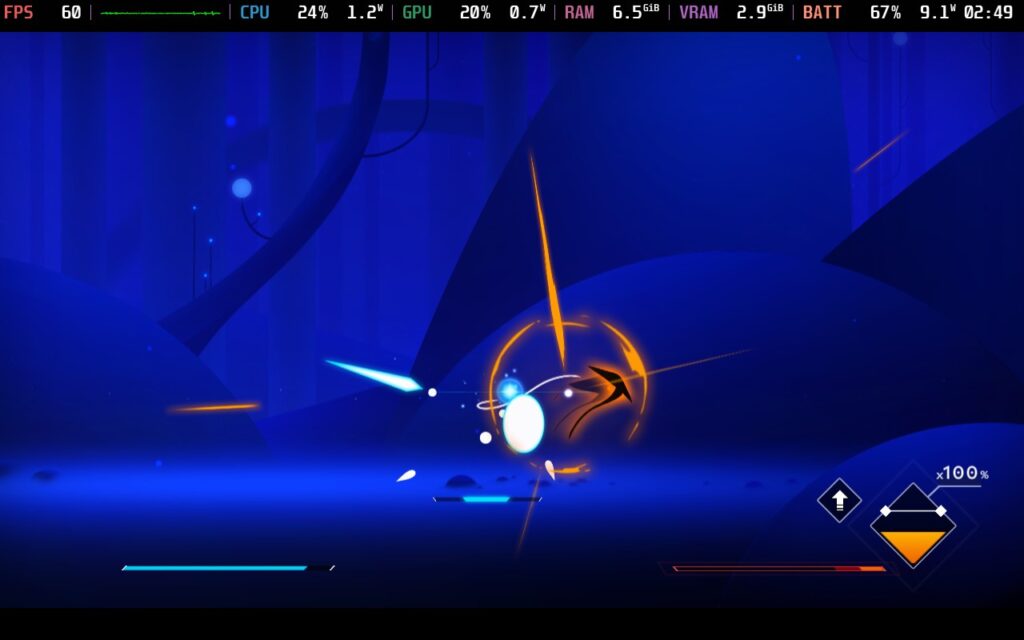
With such a low TDP limit, we can squeeze close to 5 hours from the Steam Deck's battery here. Because of that, I recommend just playing this game at 60 FPS. Battery draw varied between 7W and 9W. When doing platforming elements and exploring the world, the battery draw stays pretty low, and when in combat, it tends to edge up towards 9W of usage. Regardless of what you're doing in the game, you should expect at minimum 4 hours of battery life from a full charge.
I did a test at 3W TDP Limit to see if that would help improve battery life, too. In this setting, we had to drop the FPS Lock to 40 FPS; however, the battery draw remained similar with maybe only an extra few minutes added on. Given the timing nature of combat, 60 FPS is the way to go here.
Ultimately, I found that when you're running this low of a TDP limit, your screen brightness will have a large impact on your battery. I always play at 100% brightness, but if you drop to 50%, you can save a good 30 minutes of battery life, if not more.
Worldless has a menu just for accessibility and has a few options to help people enjoy the game.
You can adjust controller vibration, the amount of camera shaking, and "screen flicker," which we presume is for the benefit of those with photosensitivity. You can also disable tutorials and adjust the gamepad symbols between Xbox, PlayStation, and Nintendo.
The last option is a bit of an odd one, but it does make sense, as the game uses on-screen controller symbols and requires you to press them in order at points, so having the correct symbols for your controller on-screen is very helpful.
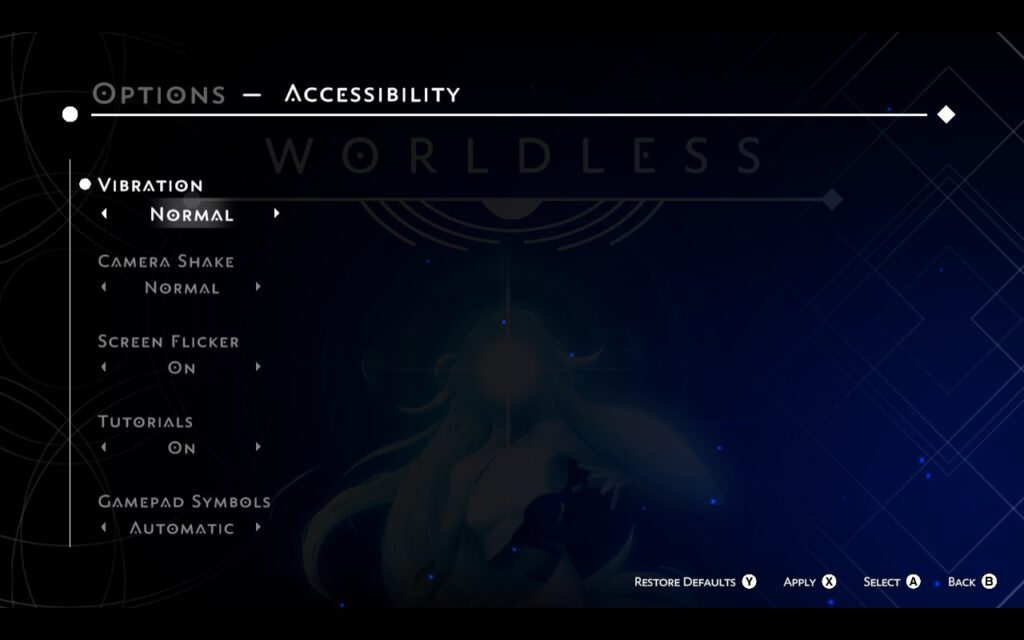
Worldless was an enjoyable experience, although the game is a bit short, seeing as I gained the majority of the skills in the game within the first 2 hours. The visuals are appealing and the combat system is great, feeling especially good when landing that perfect combo for massive damage. The puzzles are simple, but as I'm not much of a puzzler, I can't complain about that! The core gameplay loop is figuring out where you haven't defeated enemies yet and navigating your way there to defeat them. Still, as both the combat and traversal mechanics hold up well, it's a perfectly satisfying gameplay loop.
The game runs great on the Steam Deck, with no need to adjust in-game settings to achieve good performance. If you want a Metroidvania to play on your Steam Deck, Worldless may be that game for you. It holds a "Verified" rating on Valve's Steam Deck Compatibility testing, which is completely accurate here, and "Very Positive" reviews from Steam users at the time of writing this review.
Our review is based on the PC version of this game.
If you enjoyed this review, be sure to check out the rest of the content on SteamDeckHQ! We have a wide variety of game reviews and news that are sure to help your gaming experience. Whether you're looking for news, tips and tutorials, game settings and reviews, or just want to stay up-to-date on the latest trends, we've got your back.
Dead Cells is a 2D rogue-lite that is heavily inspired by the metroidvania genre. You will treck through gorgeous, unique environments fighting enemies with an array of weapons and items. The game will require precision and thinking on your feet as you'll have to roll, jump, and climb your way through obstacles and weigh the choices of everything you pick up to become a deadly force to be reckoned with. After each death, you will be able to come back and buy permanent upgrades, and then head right back into the non-linear world where you will find even more secrets, hidden passages, and much more.
Dead Cells is quite possibly one of the greatest rogue-like games I have ever played. The incredible visuals, detailed landscapes, and addicting gameplay loop all come together seemlessly in an amazing combat system that feels fluid with its varied weapons and dodging. This is only made better with the free updates it has gotten, as well as the DLC that have been released for it, which add in new locations, weapons, bosses, and much more. Speaking of which...
The Castlevania DLC for Dead Cells was provided to us by Motion Twin and TinsleyPR for review. Thank you!
The Dead Cells: Return to Castlevania DLC released 3 days ago and I have to say, whoever came up with this idea deserves a large raise. I don't recall one time I felt a crossover fit so well into a game. 2 new biomes, 14 new weapons, 3 bosses, 20 outfits, new enemies, over 60 added music tracks, and a new storyline featuring Richter and Alucard are all part of this $10 package and it is incredible.
After you die a couple times, you will be able to start accessing the Castlevania content, which will be confirmed when you see red bats fly across your screen. From there, just find Richter in the prison and he will start you on your journey into the new storyline.
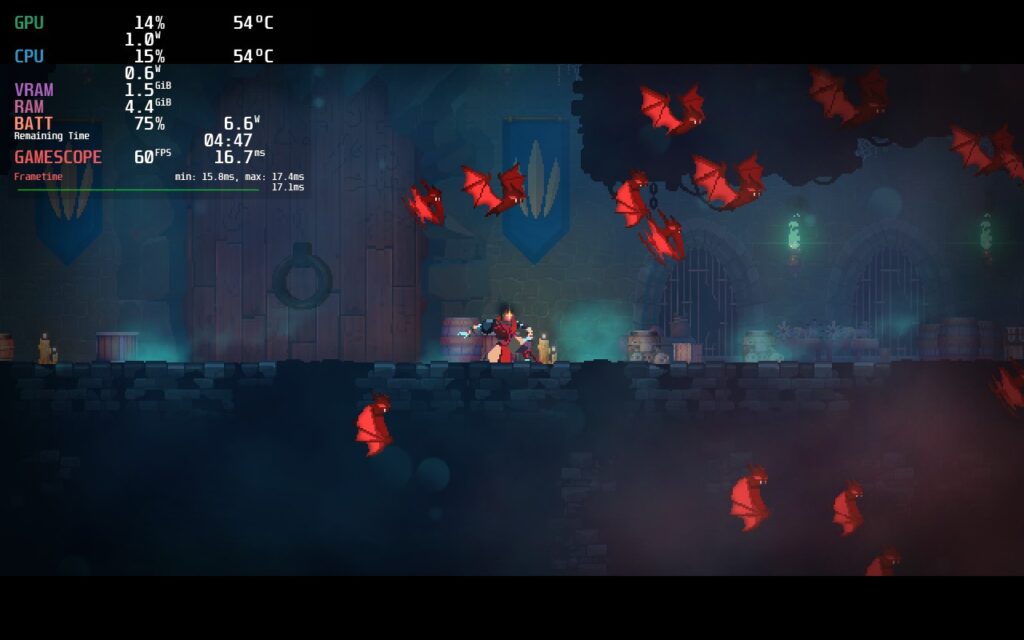
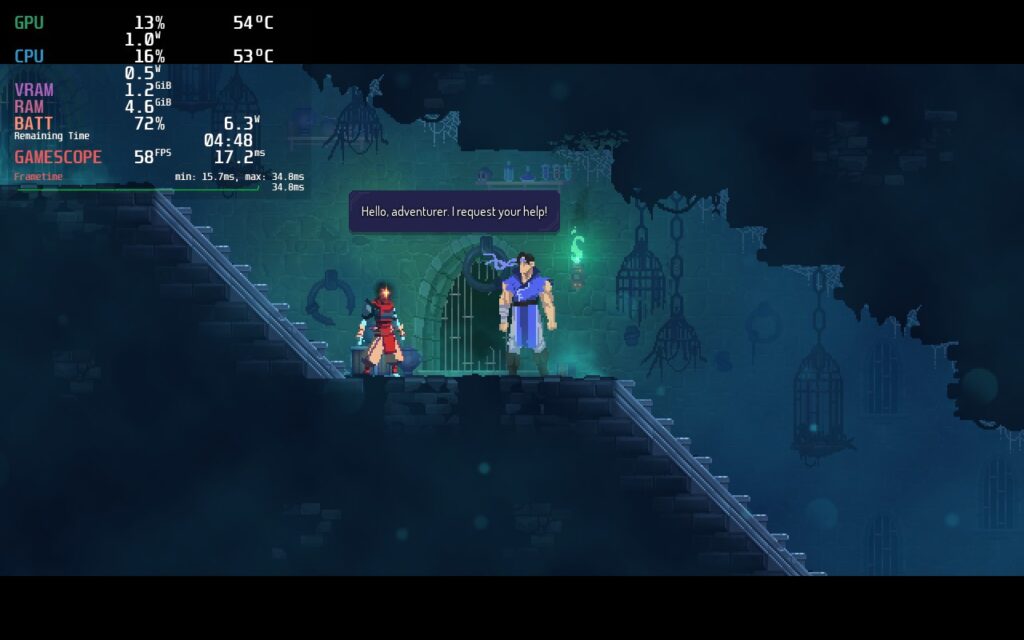
There is so much I can really say about this expansion, but I can't stress enough how incredible it is. The new weapons, like the Cross, Morning Star, Bible, Vampire Killer, and Holy Water, fit in perfectly, the outfits are great, the music tracks are fantastic, the biomes are gorgeous, and the boss fights...oh the boss fights are epic. I had just made it through Dracula's castle and I thought I was heading to fight him, but no, I was pulled down by a purple chain to be killed by Death, which was an insane battle.
On top of that, being able to put on outfits of Castlevania characters and make yourself look like Richter, Simon, Alucard, Maria, Trevor, and even Dracula while fighting classic enemies of the franchise like Medusa, Werewolves, Buer, Armor Knights, Throw Masters, and more! Overall, for $10, this feels like a steal. And for those who don't have it, there is a bundle for $25 for both the base game and this expansion. I highly recommend it if you haven't taken the dive yet.
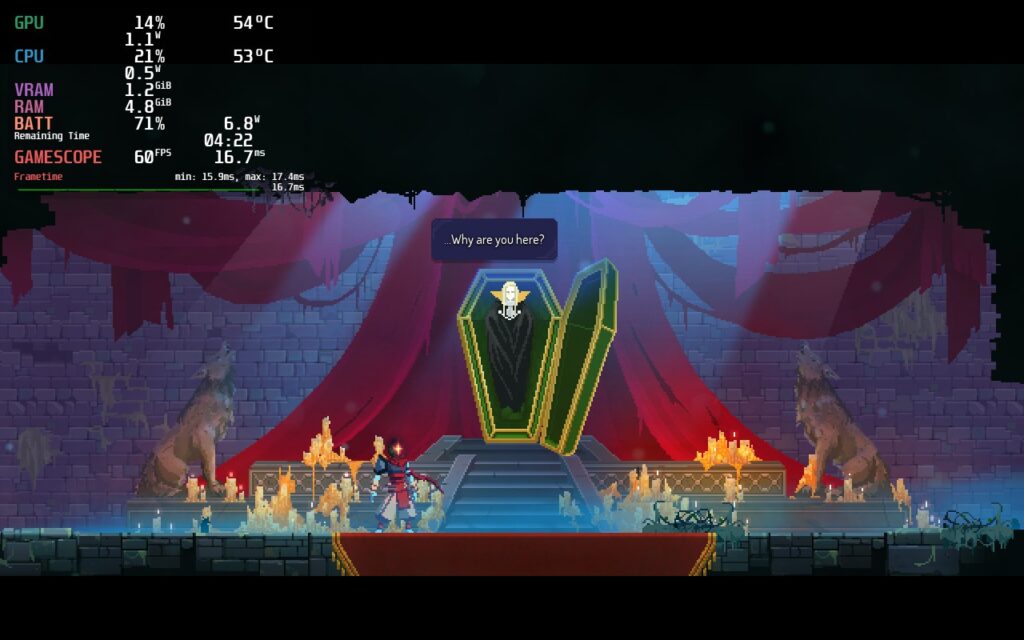
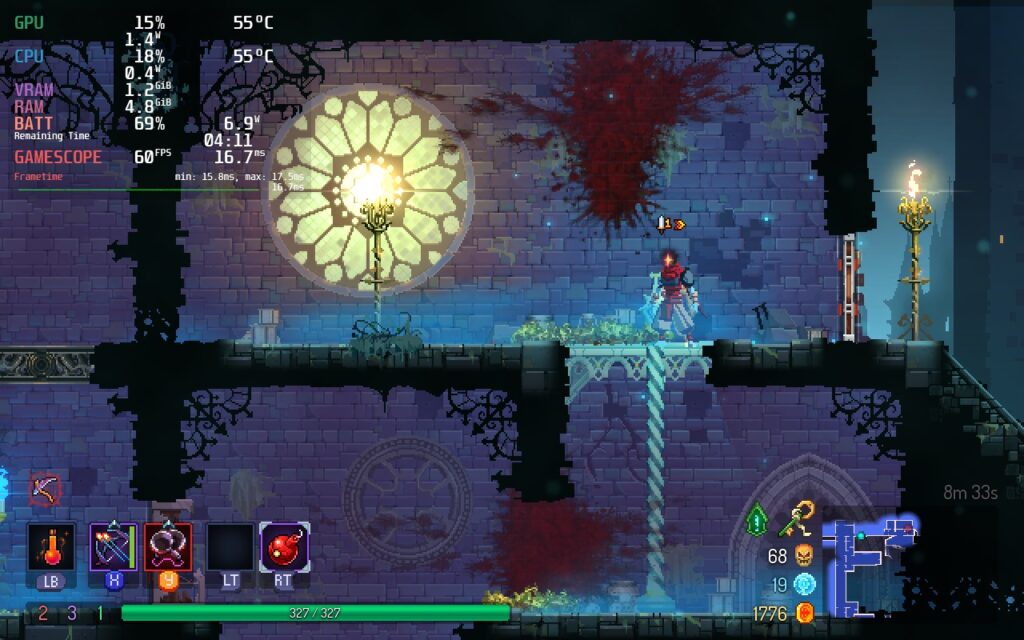
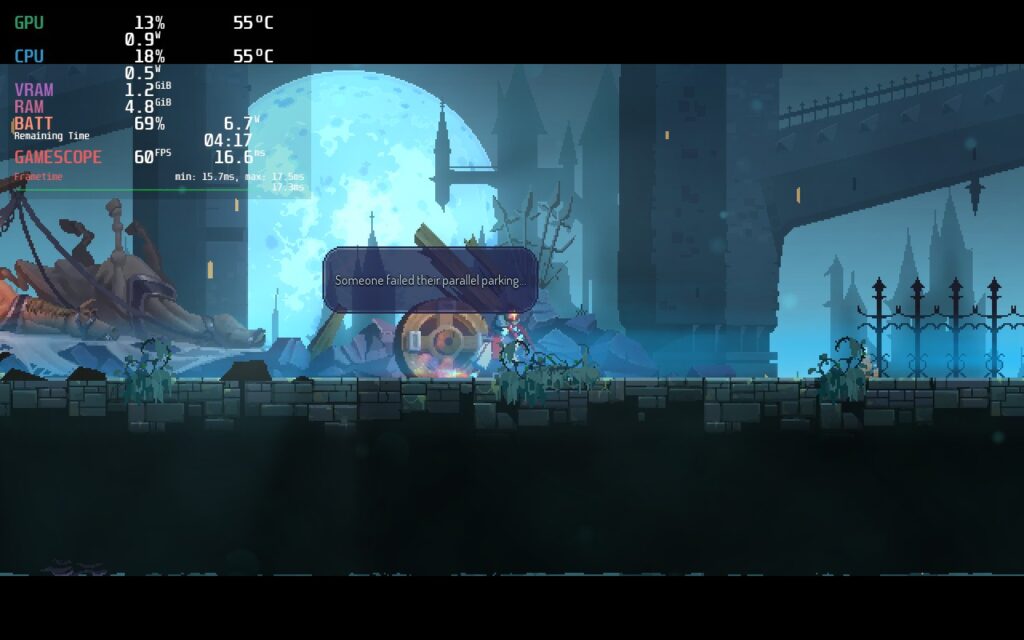
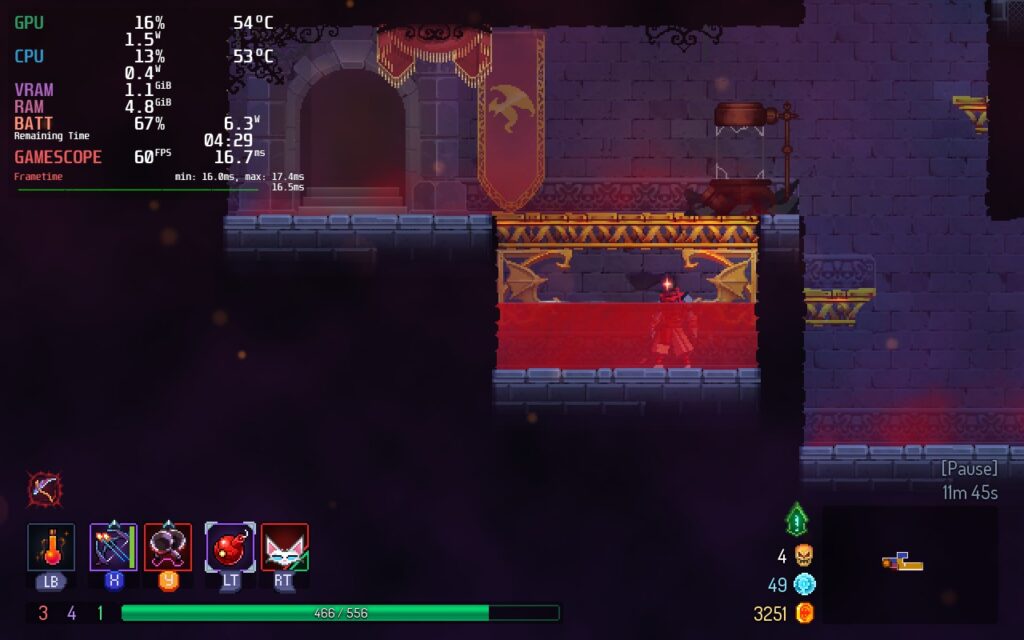
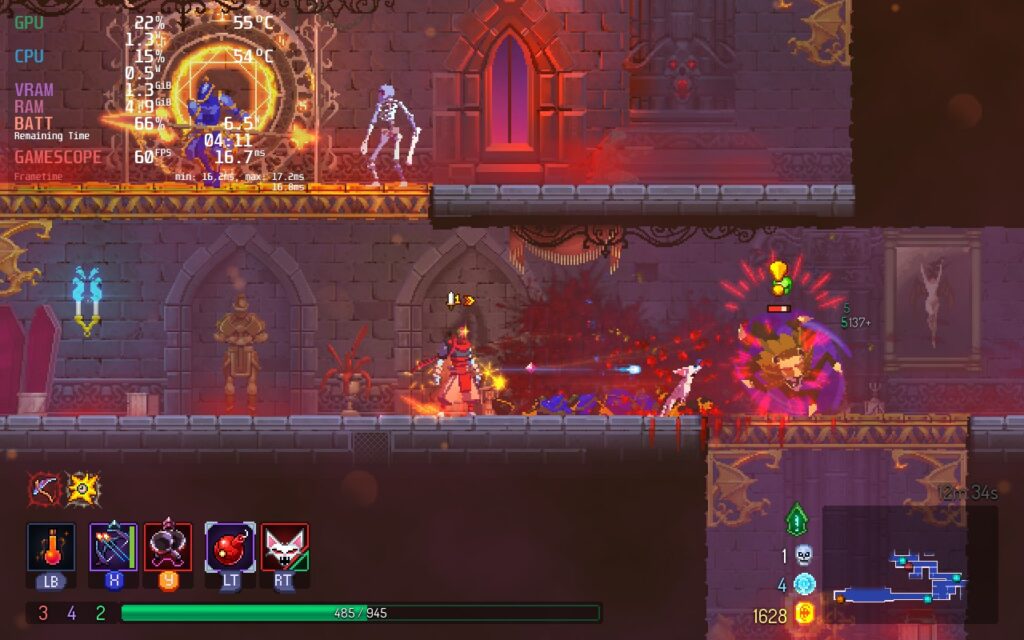
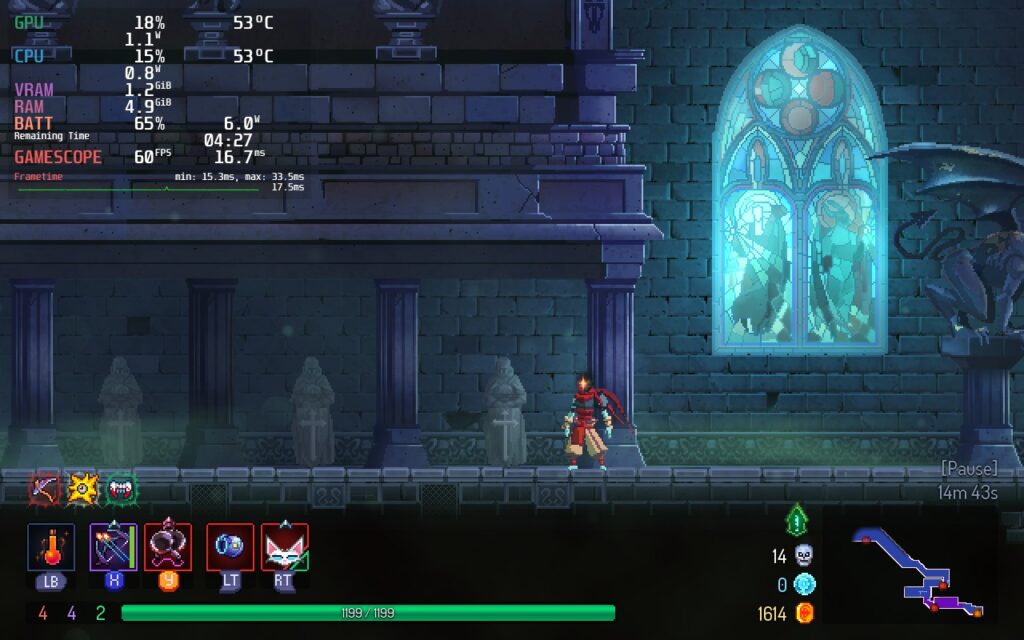
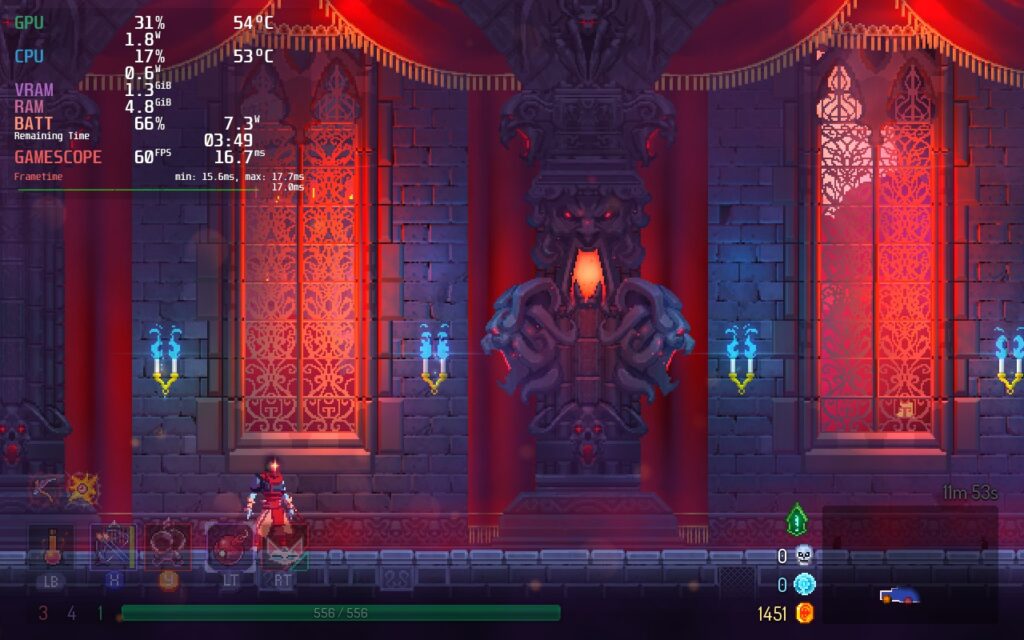
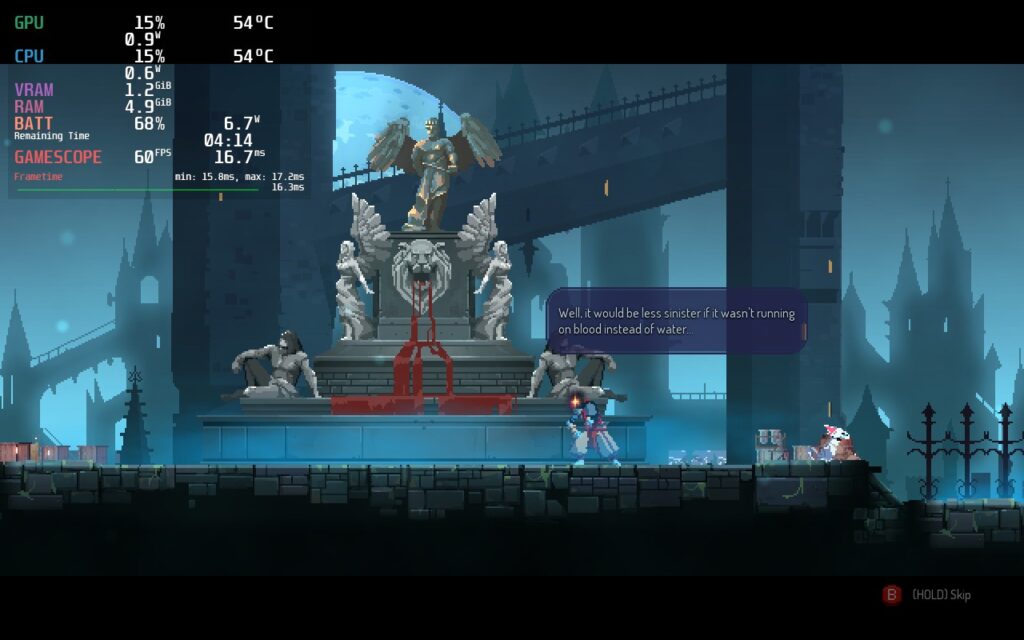
With how amazing Dead Cells is, it's only made better by how perfect it runs on the Steam Deck without any changes! The game will drain around 6W - 8W for a battery life of 6.5 - 7 hours at a solid 60 FPS. There are some small stutters here and there, but I only noticed because I had the overlay on, otherwise, I wouldn't have at all!
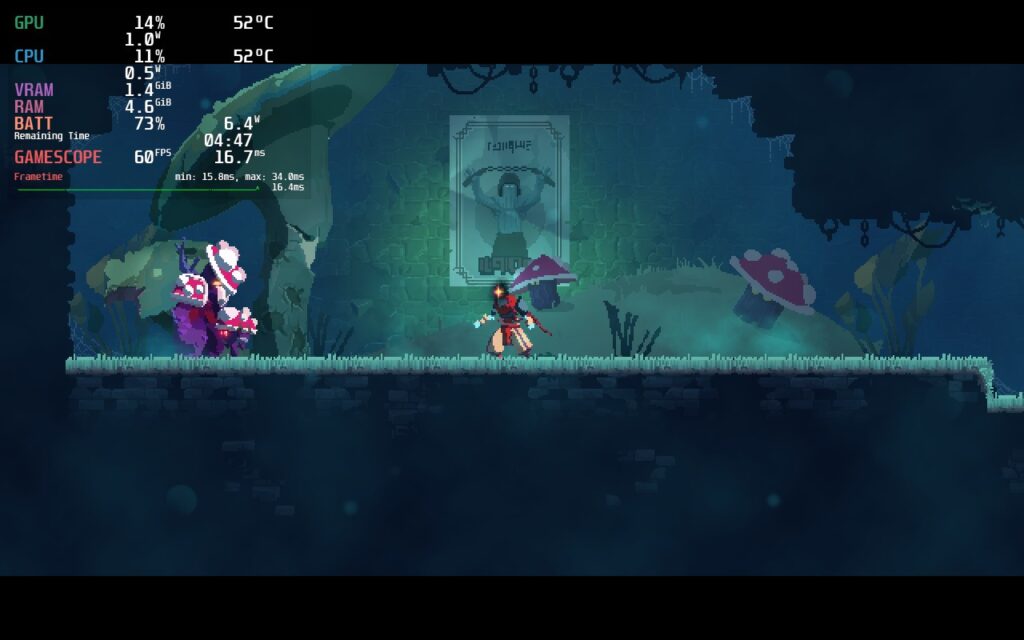
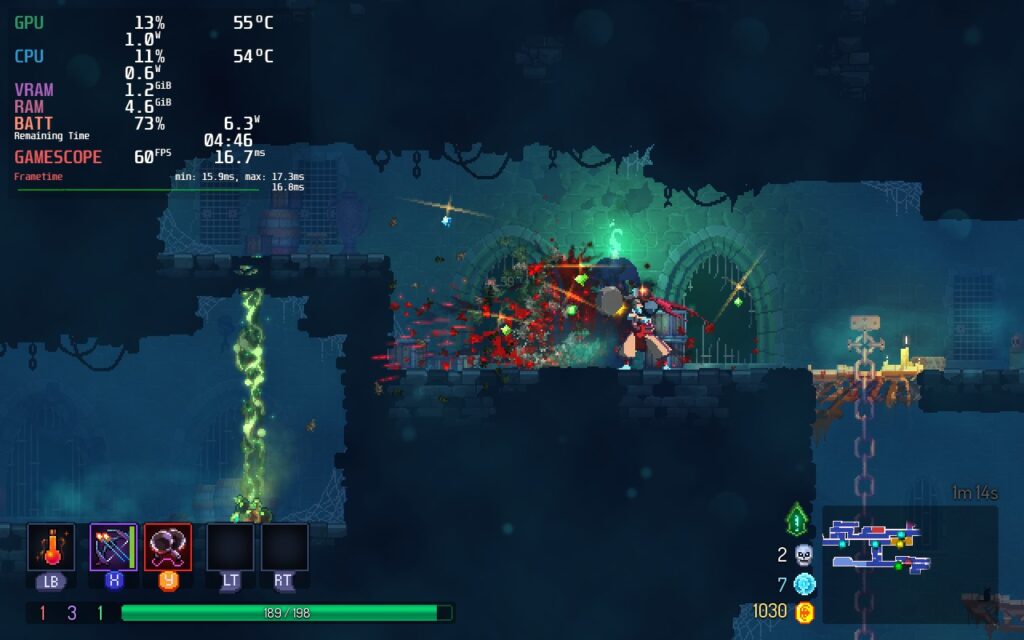
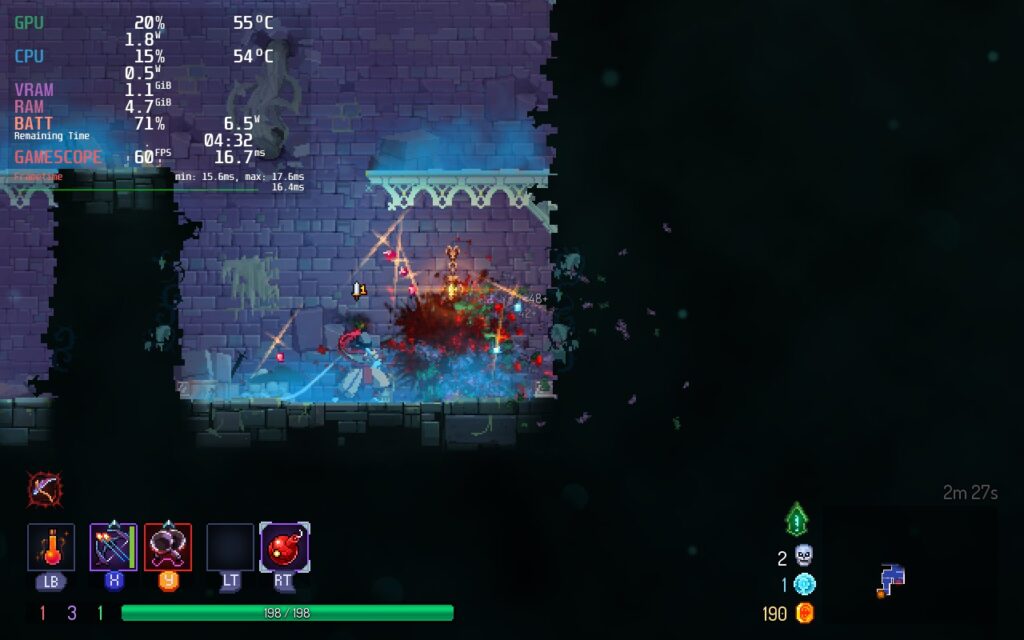
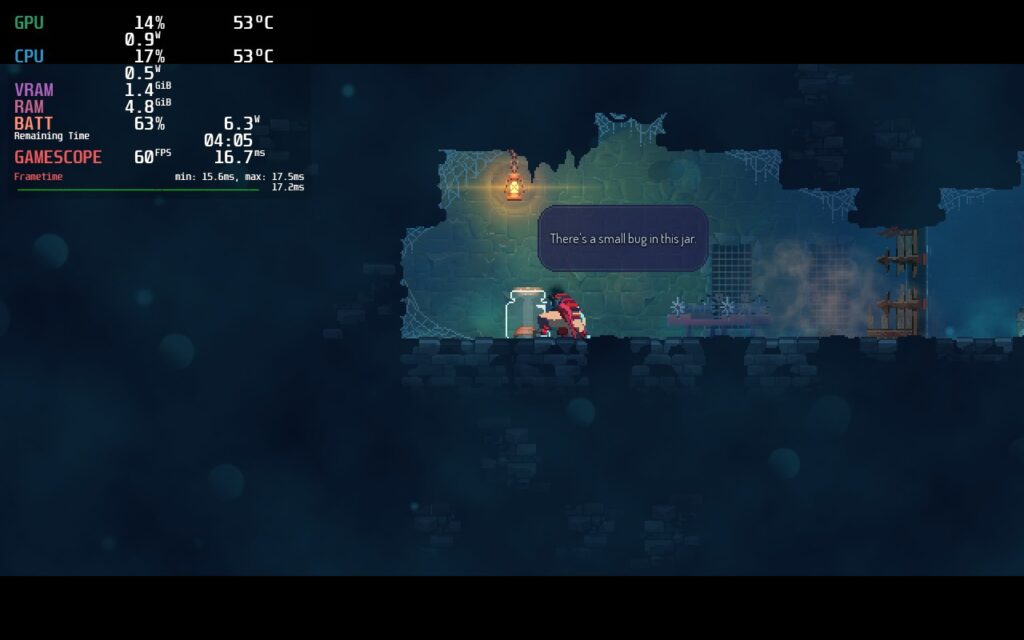
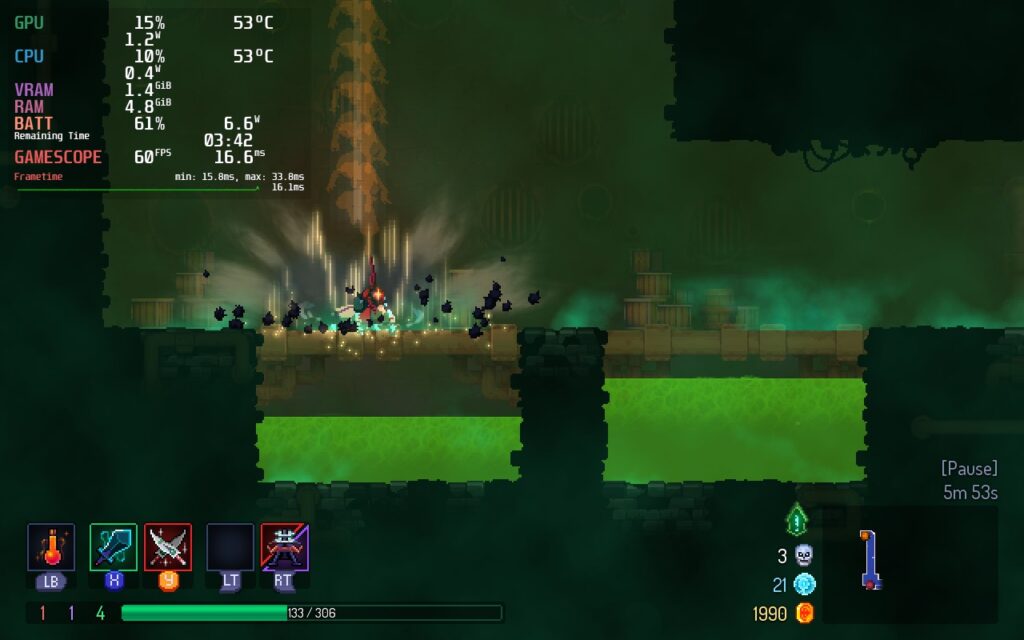
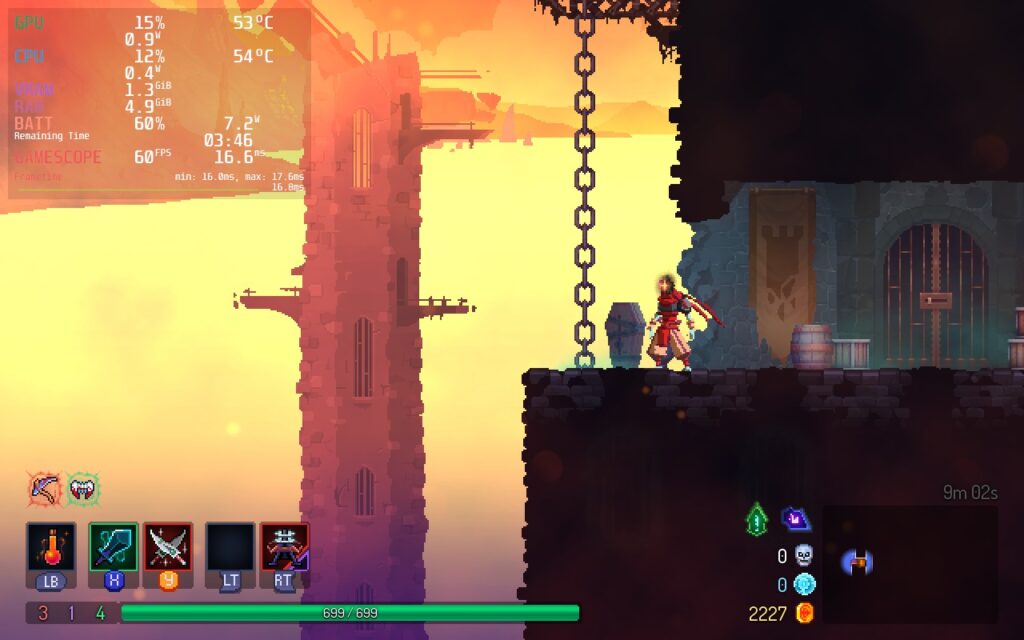
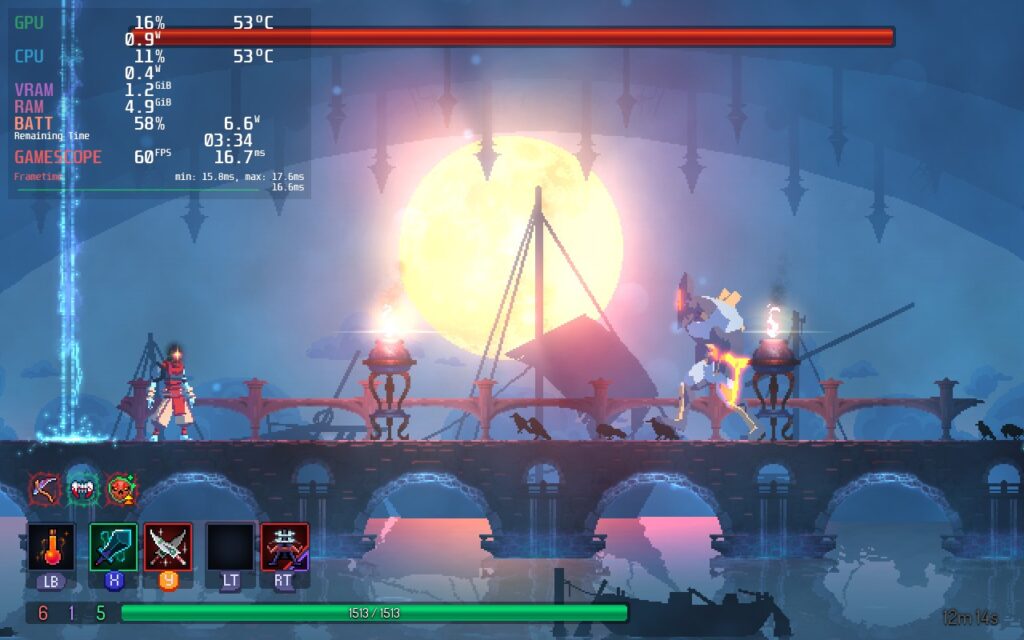
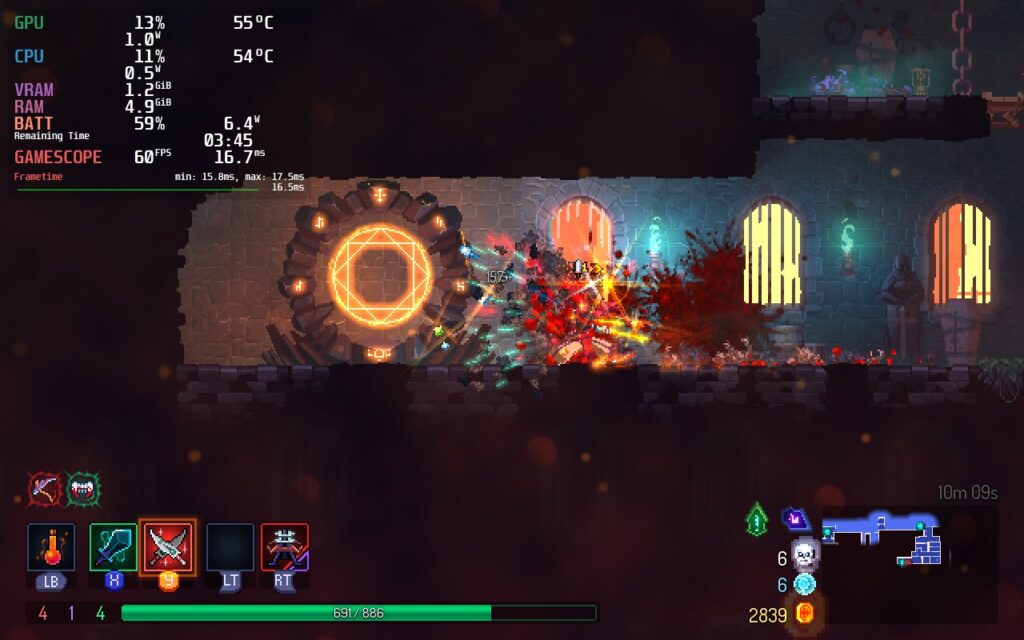
I had no issues with controls or visual bugs that appeared. In cutscenes, the screen would turn into letterbox format, but it went right back to the 1280x800 resolution it supports. To make things even more appealing, Dead Cells is being played through a native Linux build, and it runs fantastically.
Dead Cells is one of my personal favorite games. I am a huge fan of roguelike and metroidvania games, and this game does a wonderful job blending the two and refining it to a tee. And with the release of the incredible Return to Castlevania expansion, there is even more reason to jump in now if you haven't. If you don't have this expansion, I highly encourage checking it out, it is $10 well spent! Thankfully, you will also be able to fully enjoy it on the Steam Deck with no compromises needed, making it one of our Best on Deck games! Dead Cells and the Castlevania DLC are essentials to your Deck's library.
Our review is based on the PC version of this game.
If you enjoyed this review, be sure to check out the rest of the content on SteamDeckHQ! We have a wide variety game reviews and news that are sure to help your gaming experience. Whether you're looking for news, tips and tutorials, game settings and reviews, or just want to stay up-to-date on the latest trends, we've got your back.
Ghost Song was provided by Humble Games to review. Thank you!
Ghost Song is a metroidvania with some souls-like gameplay elements all wrapped up in a gorgeous-looking package. As a long-dormant deadsuit that has woken up, you will traverse the depths of the desolate moon of Lorian on an adventure to discover who you are. Along the way, you will encounter cosmic threats and ancient mysteries all while acquiring new abilities to crush those standing before you. Will you be able to handle the truth nesting itself in the darkness and overcome?
Ghost Song is by far one of the most beautiful metroidvania games I have played recently. The artwork and atmosphere is pristine, while the combat mechanics felt fantastic. Unfortunately, this was hampered a bit by the amount of backtracking and lack of enough fast travel points. I liked going through and seeing the serene underground as I ran through, it felt tedious with the amount I had to do. I also felt the save points were a bit sparse, which made itself apparent the more I played and constantly died, losing hours of progress (some of this was me forgetting to save). The movement system felt a little static at times too, but it didn't inhibit my enjoyment. Overall, I felt this was a great game and I was absolutely having a great time playing this, and with some tweaking, this was a wonderful experience on the Steam Deck!
In the beginning, I noticed the game defaulted to a 16:9 aspect ratio of 1280x720, which is fine, but was draining the battery around 14W - 15W, which I felt was a bit high considering Ghost Song is a 2D game. It was able to handle 60 FPS for the most part, but I noticed that in some areas, and when some particle effects were happening, the game would spike and drain way more battery than it should. Luckily, just a couple setting changes actually capped the game at 13W, while also expanding the resolution to cover the entire 16:10 screen.
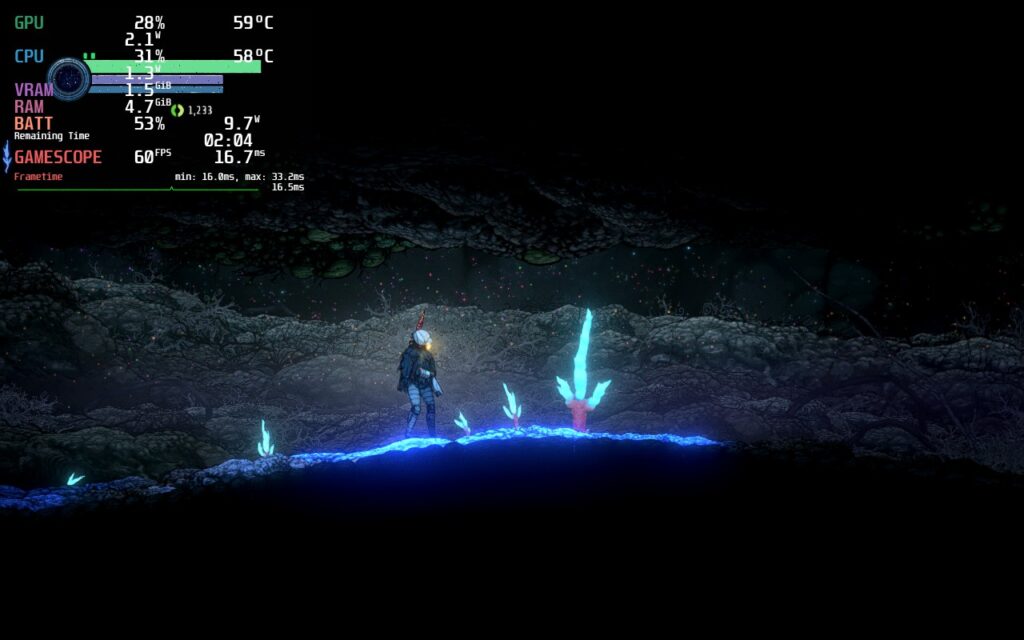
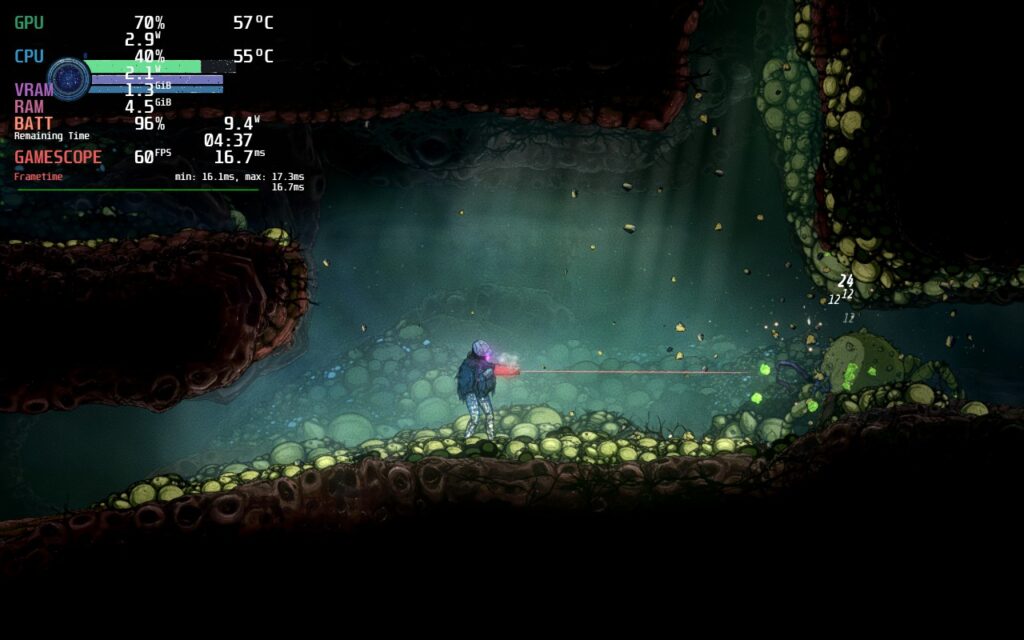
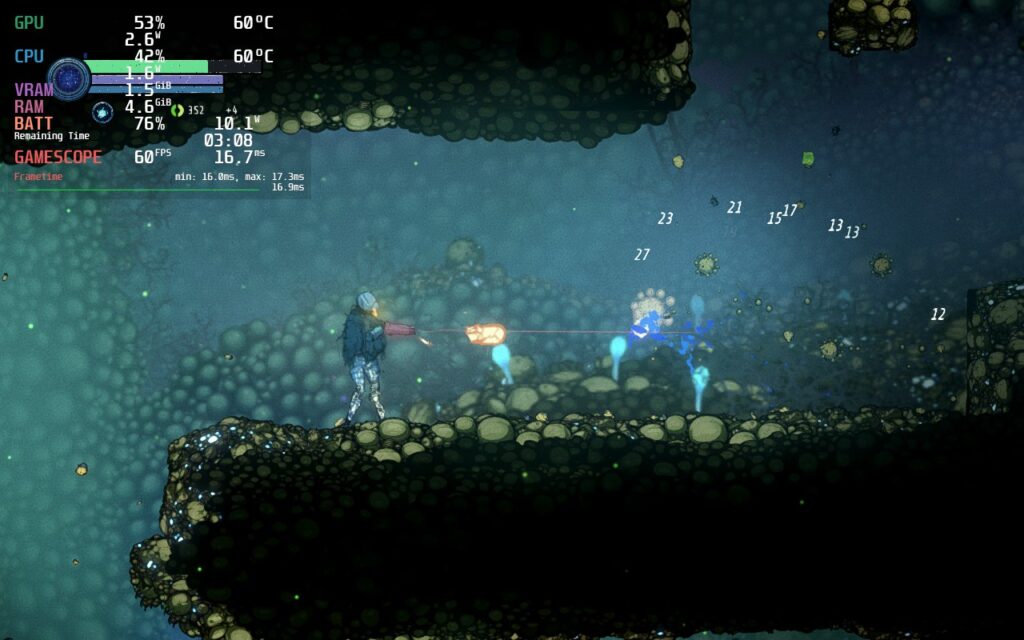
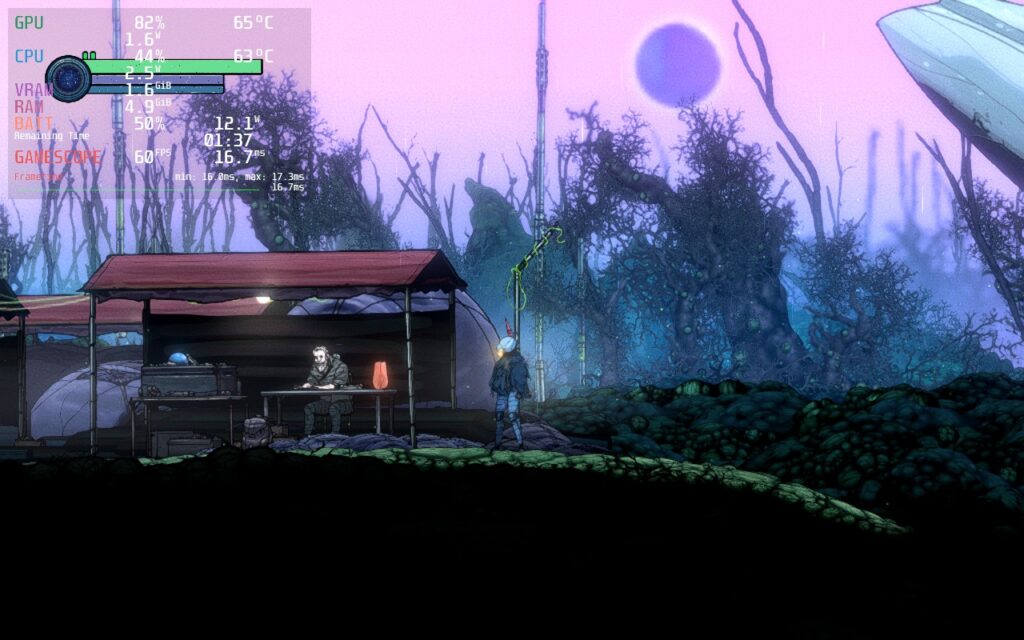
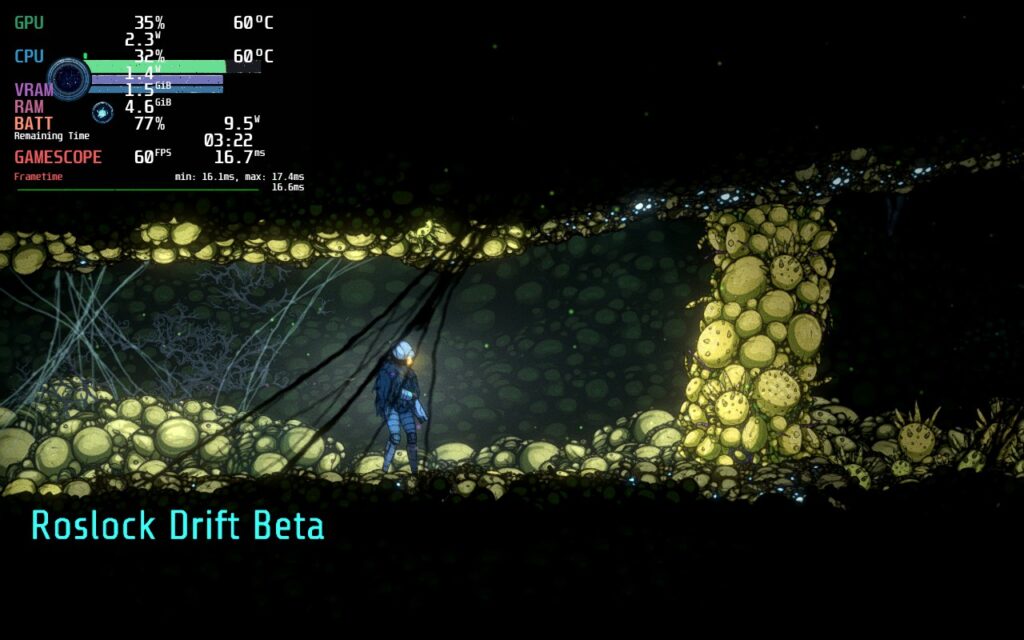
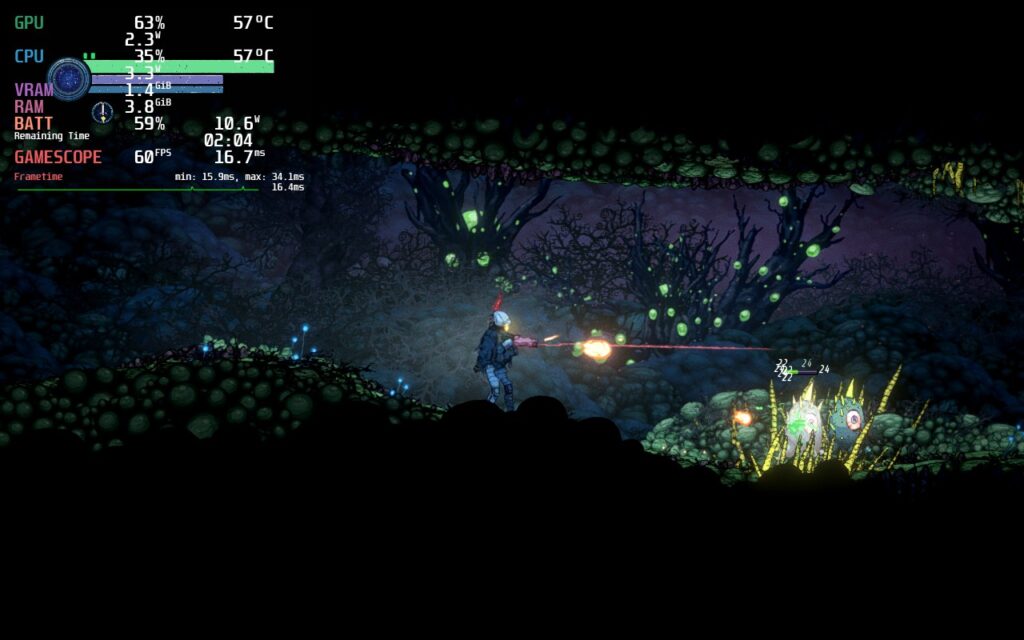
By going into the preferences of the game and using Steam to force the resolution to 1024x640, Ghost Song had not only covered the entire screen of the Deck, but also saved a significant amount of battery life while keeping 60 FPS. Using a TDP limit of 7, the game stuck at 60 FPS and kept a battery drain of 13W or under. I also used FSR to upscale the game and compared to the native 1280x720, it looks significantly better!
While I could make a battery build that pushes framerate or resolution down further, I feel this hurts the overall experience of the game. Any lower framerate makes the game feel much less smooth and, while it could be brought down to 55 and still feel mostly smooth, it felt something was off when I was playing it. And resolution down further would help battery too, but start to lose too much quality that it doesn't need to. A quality build for Ghost Song would be just bumping up the framerate and unlocking the TDP limit.
From time to time, in certain areas, I did encounter a little stuttering. This really only happened when I was running around areas and not in combat, which I am thankful for, but it still happened enough for me to notice. Since it wasn't during my fights, I didn't feel it really affected my enjoyment of the game since it held strong where it counts! I also didn't find any controller issues or visual bugs, it just fit perfectly in the handheld format.
While a lack of save points and a lot of backtracking with a more static movement system was plaguing the game, the pros outweighed the cons. The vibrant and beautiful visuals, the fantastic atmosphere, and great combat system all worked together really well to create a wonderful experience I am happy to have played. And with these adjustments, Ghost Song plays extremely well on the Steam Deck.
If you enjoyed this review, be sure to check out the rest of the content on SteamDeckHQ! We have a wide variety game reviews and news that are sure to help your gaming experience. Whether you're looking for news, tips and tutorials, game settings and reviews, or just want to stay up-to-date on the latest trends, we've got your back
Tunic is a top-down isometric action game reminiscent of the good old Zelda days. You play as a little fox and explore an island filled to the brim with secrets, treasure, and pages of the game’s manual that you can put together. You will also come across unique enemies and colossal beasts while uncovering new secret techniques and relics. The world is absolutely gorgeous with a colorful, yet simple art style that pops out and pleases the eye at every turn. Paired with a pleasing combat system and a plethora of secrets, Tunic is a game worth discovering.
Luckily for Deck users, Tunic is not an intensive game. The game’s recommended settings were actually the maxed out ones at native resolution, and after some initial testing, I can happily say it will run most of the time at 60 FPS. With temps around 65-70, depending on the area, and battery sticking average around 15W, playing like this is possible, but it can be improved. If you do decide to play at max settings, make sure the TDP is set to 8 as well to avoid it using too much power.
I decided to try to curb these FPS spikes first. Through my testing, it turns out SSAO (Screen Space Ambient Occlusion) was causing most of them. SSAO is used a lot in Tunic and really makes the world pop just a bit more, but turning it off almost instantly fixed most of the spikes. I do believe that SSAO on medium works very well while retaining the quality it gives.
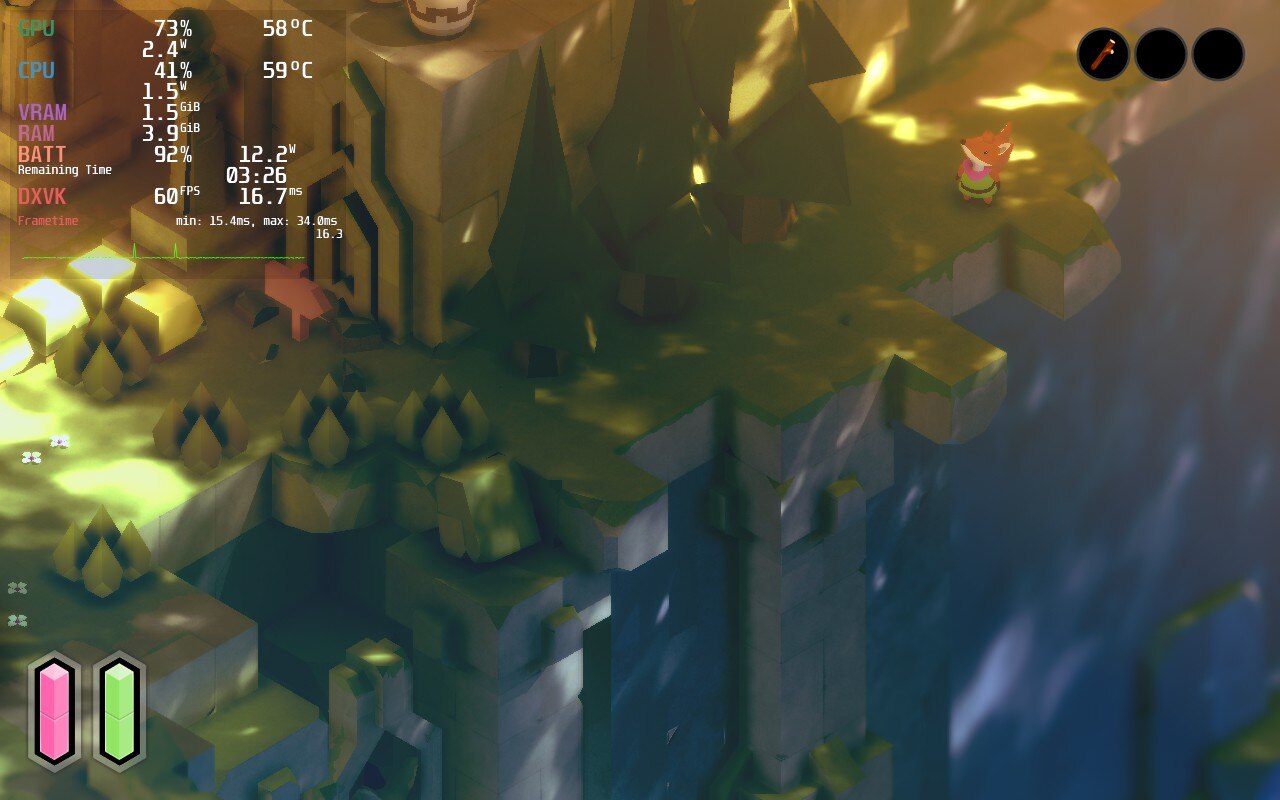
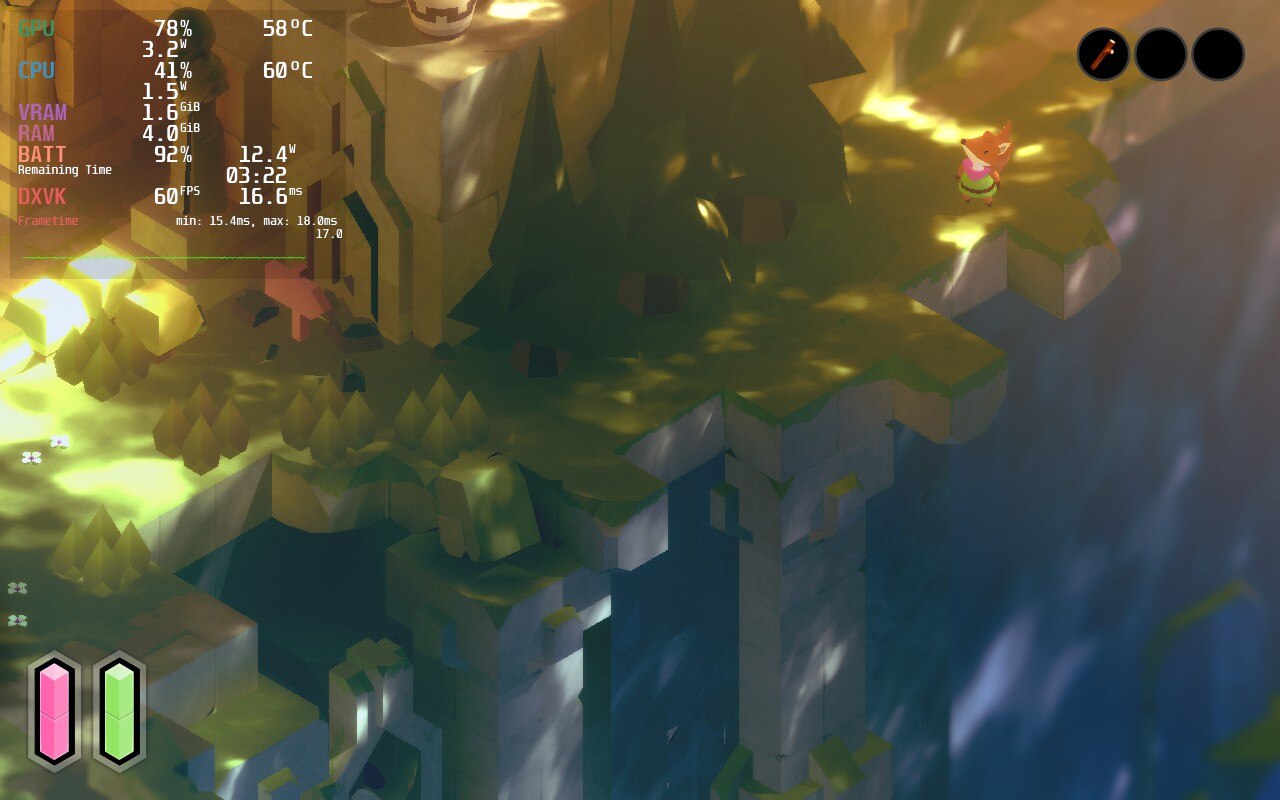
While there is a difference, it didn't affect the overall aesthetic of the game and ran much more smoothly.
I also decided to limit the TDP to make sure it didn’t try to go overboard on power consumption. I landed on using 8 as it kept the game at 60 FPS and temps down to an average of 65. Limiting the TDP did mean some of the graphically intensive areas ended up causing framerate drops to around 45-50, but I remedied that by turning shadows to low (which showed almost no visual difference to me) and brought resolution down to 1152x720. Paired with FSR upscaling and sharpness of 1, the game looked almost exactly the same as native. I did turn off FXAA as well, which made corners of all models look sharper, but I feel it makes the game stand out more with reduced graphical quality.
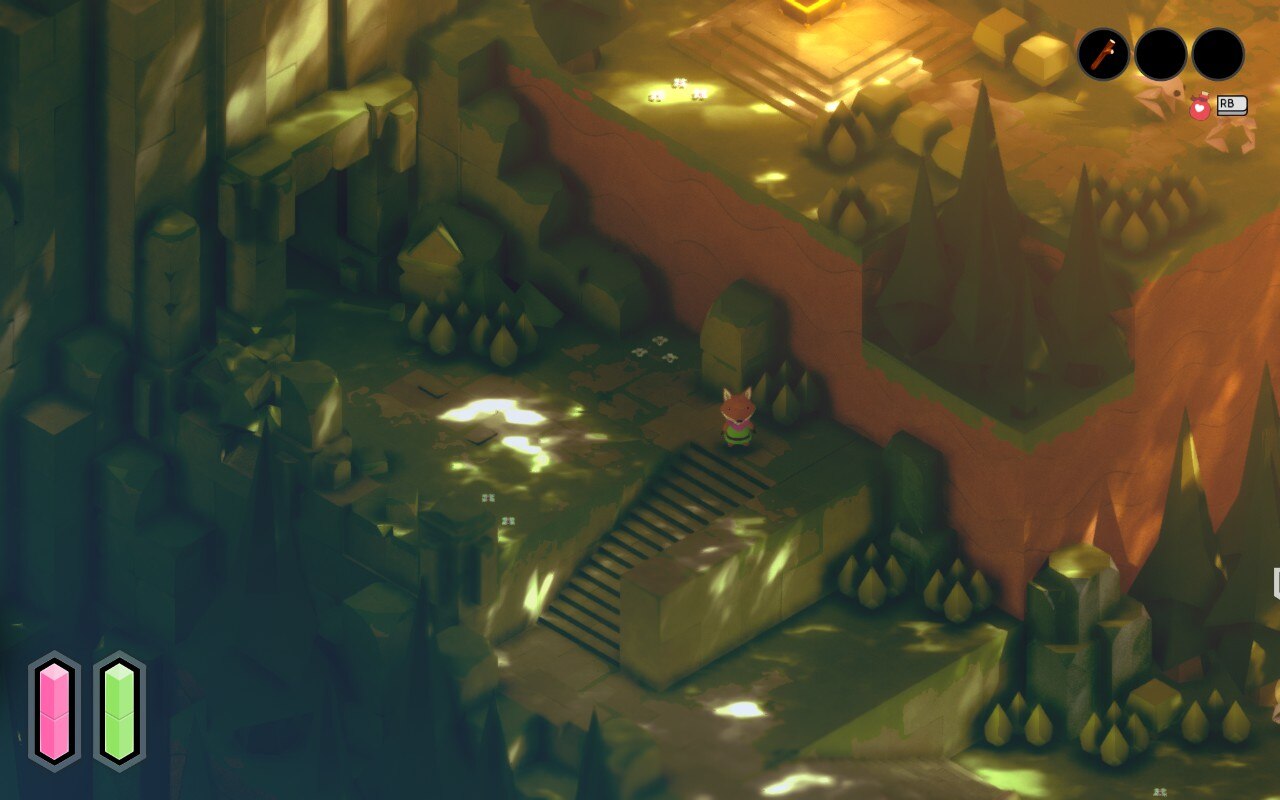
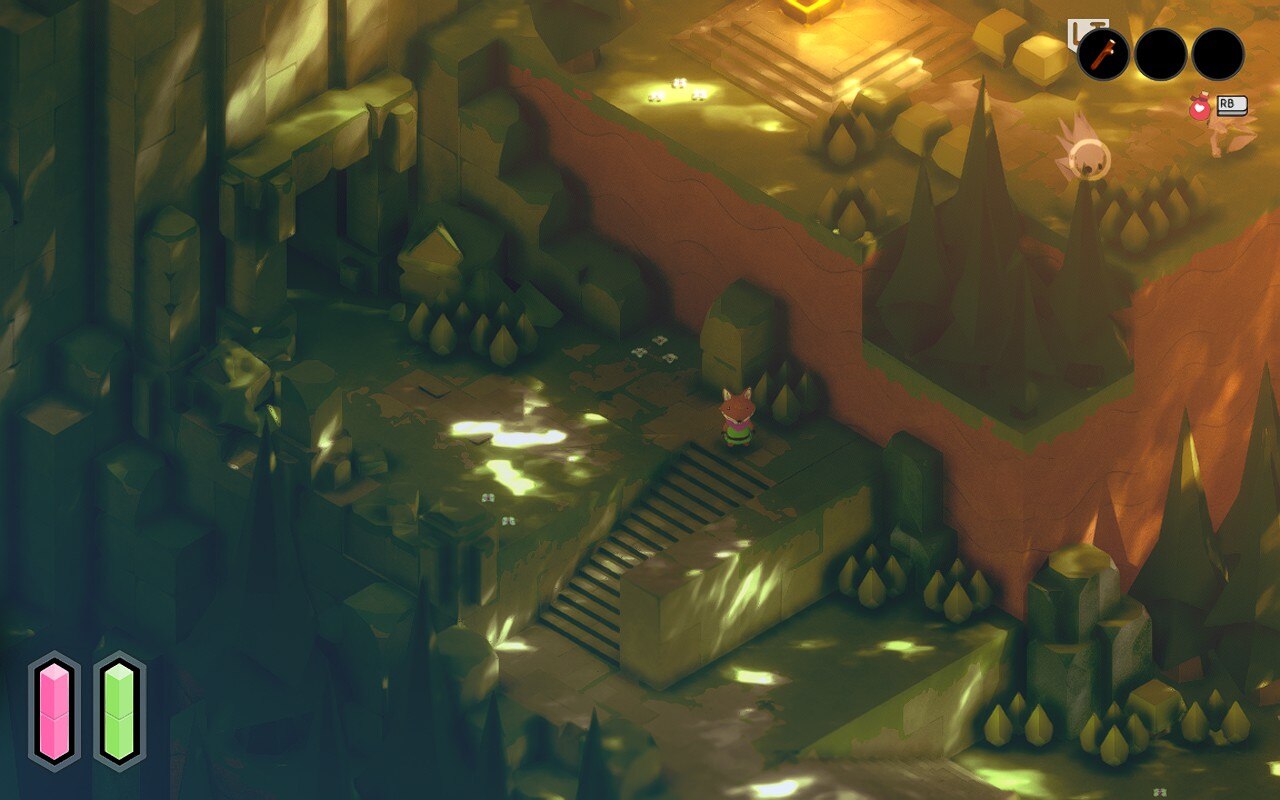
1280x800 vs 1152x720 really didn't show a significant difference to quality, but did provide a more stable 60 FPS.
It is possible to turn everything off or to low and set the resolution to 960x600 and upscale that to save as much battery as humanly possible while still looking pretty decent. While changing resolution down to 1152x720 didn’t affect the battery as much, going to 960x600 with the same settings did lower it by about 1-2W. This also creates a super stable 60 FPS with almost 0 drops at all. The game still looked quite good for the most part though, but it was obvious that there were some downgrades to it. Turning FXAA off does help tremendously with a lower resolution and FSR though.

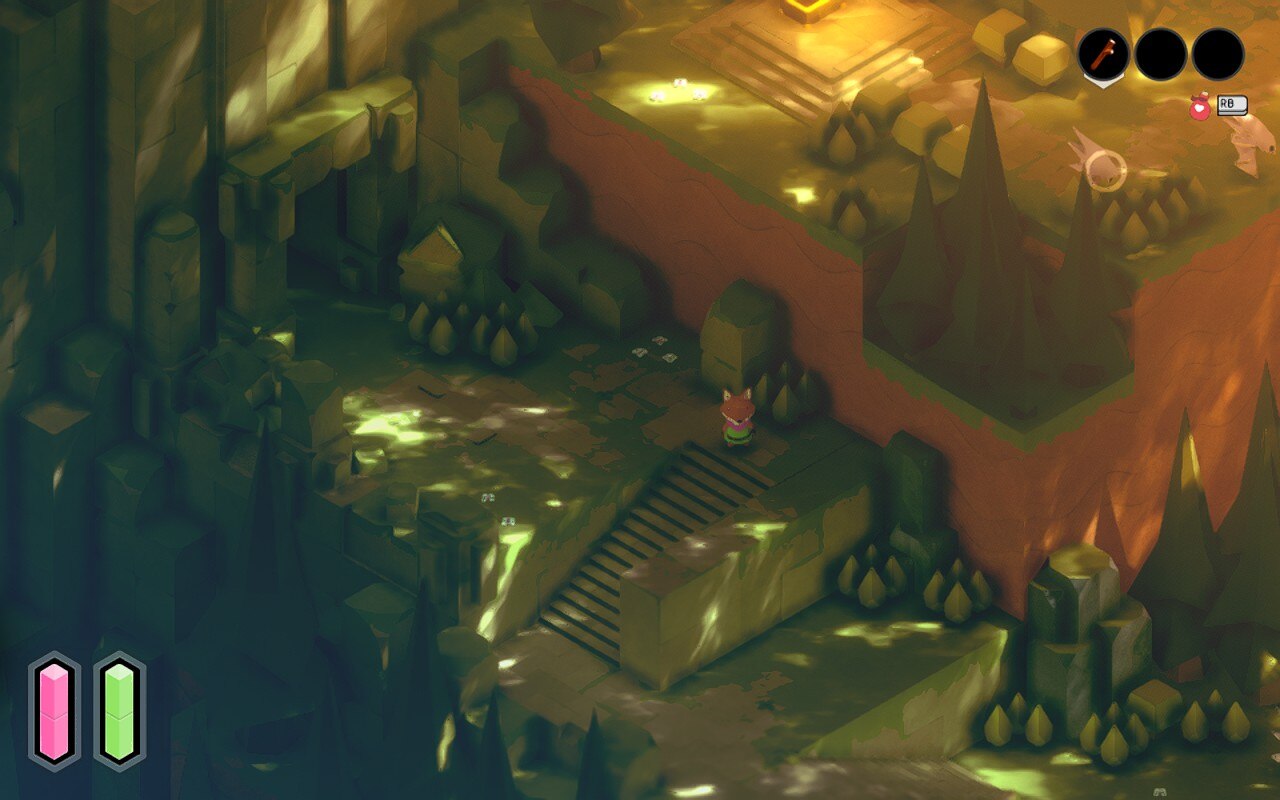
1280x800 vs 960x600 definitely showed more of a downgrade in quality, but it wasn't horrible.
Luckily, no bugs or glitches were caught and the game ran smoothly in general. Tunic is a game meant to be played at 60 FPS though, so any drops were quite noticeable. If it wasn’t, I would say the game is 100% playable from maxed settings all-around, but it did hurt my eyes a bit in the areas where there were a lot of SSAO effects on screen and the framerate dropped to 45.
All-in-all, Tunic is a really fun game to play. The gameplay and artstyle mesh together very well, while the stable performance on the Deck make this a wonderful game to take on the go. I didn’t expect it to be a powerhouse game really, but it did perform better than I expected after minimal changes to the settings. Personally, I prefer a sharper look and stable 60 FPS for a game like this, and luckily, it was able to hit that quite easily.
Our review is based on the PC version of this game.
If you enjoyed this review, be sure to check out the rest of the content on SteamDeckHQ! We have a wide variety game reviews and news that are sure to help your gaming experience. Whether you're looking for news, tips and tutorials, game settings and reviews, or just want to stay up-to-date on the latest trends, we've got your back!